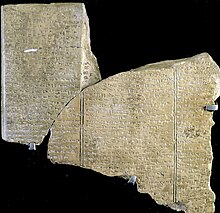
Back Baälsiklus Afrikaans دورة البعل Arabic Cicle de Baal Catalan Ugaritischer Ba‘al-Zyklus German Baal-ciklo Esperanto چرخه بعل Persian Cycle de Baal French עלילות בעל וענת HE Ciclo di Baal Italian Baal-syklusen NB

| Ugarit |
|---|
 |
| Places |
| Kings |
| Culture |
| Texts |
The Baal Cycle is a Ugaritic text (c. 1500–1300 BCE) about the Canaanite god Baʿal (lit. "Owner", "Lord"), a storm god associated with fertility.
The Baal Cycle consists of six tablets, itemized as KTU 1.1–1.6. Tablets one (KTU 1.1) and two (KTU 1.2) are about the cosmic battle between the storm-god Baal and the sea god Yam, where the former attains victory. The next two tablets (KTU 1.3–1.4) describe the construction of Baal's palace that marks his cosmic kingship. The last two tablets (KTU 1.5–1.6) describe Baal's struggles against Mot, the god of the underworld.
The text identifies Baal as the god Hadad, the Northwest Semitic form of Adad. The stories are written in Ugaritic, a Northwest Semitic language, and written in a cuneiform abjad. It was discovered on a series of clay tablets found in the 1920s in the Tell of Ugarit (modern Ras Shamra), situated on the Mediterranean coast of northern Syria, a few kilometers north of the modern city of Latakia and far ahead of the current coastline. The stories include The Myth of Baʿal Aliyan and The Death of Baʿal. A critical edition of the Baal Cycle was published by Virolleaud in 1938.